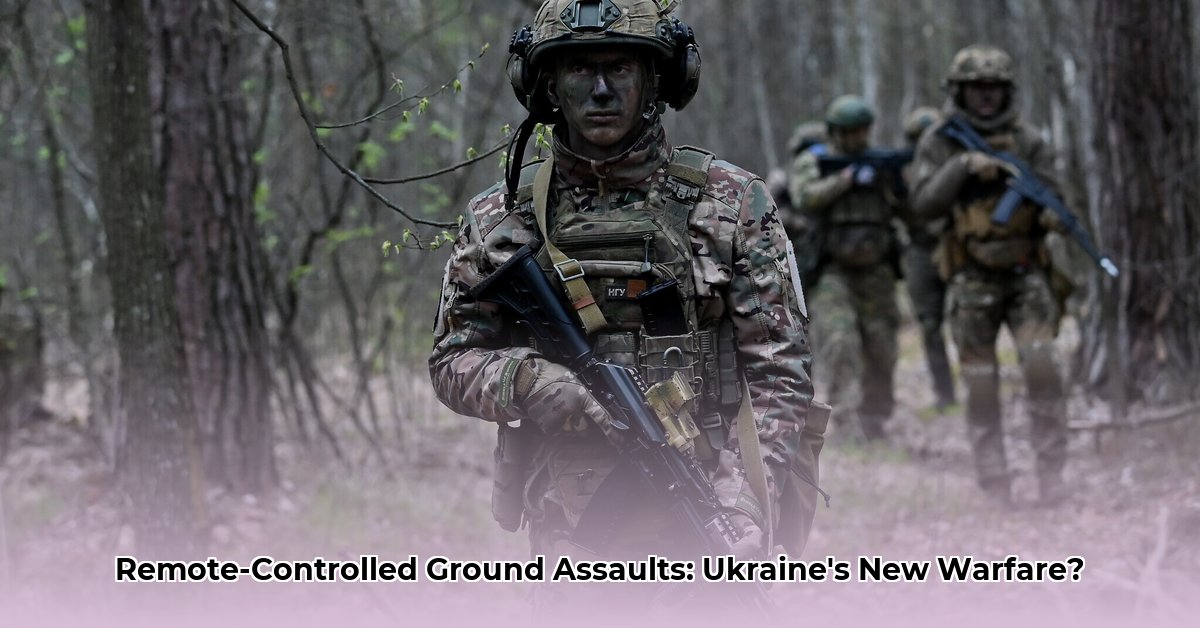Robotic Revolution on the Battlefield
In the frozen landscapes of the Ukrainian warzone, a quiet revolution is underway, reshaping the very nature of ground combat. The Ukrainian National Guard’s 13th Operative Purpose Brigade “Khartiia” is at the forefront of this transformation, pioneering the use of unmanned ground vehicles (UGVs) in a new and unsettlingly effective way. These aren’t merely support units; they are the vanguard of a robotic offensive, advancing alongside aerial drones in coordinated attacks. Armed UGVs, some equipped with machine guns, push forward under the watchful eyes of drones, while “kamikaze” drones deliver explosive payloads to enemy trenches. This innovative tactic, while potentially lifesaving for Ukrainian soldiers, raises profound ethical questions about the evolving role of robots in warfare.
Anatomy of a Robotic Assault
The Khartiia Brigade’s approach represents a significant departure from traditional infantry tactics. Their remote-controlled ground offensives involve a carefully orchestrated dance of unmanned systems. Small, tank-like UGVs, bristling with machine guns, advance on enemy positions, not just scouting but actively engaging in combat. Simultaneously, aerial drones provide real-time surveillance, feeding critical information back to the UGV operators who orchestrate the attack from a safe distance. This coordinated effort allows for precision targeting and dynamic battlefield adaptation. While the Brigade’s claim of being the “first ever” to conduct a fully mechanized, remote-controlled ground assault awaits independent verification, their use of UGVs in this offensive capacity marks a notable development.
The Future of Warfare?
This tactical shift begs the question: are we witnessing a turning point in military history? The Khartiia Brigade’s actions suggest a future where unmanned systems play an increasingly prominent, perhaps even dominant, role in ground combat. The potential impact is undeniable, raising questions about the future of military doctrine and the very nature of conflict. Will other nations follow suit, adopting similar strategies? Could this become the standard operating procedure in future conflicts? The answers remain uncertain, but the potential for widespread adoption of robotic warfare is undeniable.
Ethical Crossroads
The increasing use of robots in warfare presents a complex ethical minefield. When machines, even remotely controlled ones, make life-or-death decisions, who bears the responsibility? What are the implications for international law and the rules of engagement? These are challenging questions with no easy answers. As we venture into this uncharted territory, the need for thoughtful discussion and careful consideration of the ethical implications becomes ever more critical.
The Evolving Narrative
Many details surrounding the UGVs employed by the Khartiia Brigade remain undisclosed, including the specific models, their full capabilities, and their limitations. This lack of transparency is not uncommon in the realm of military innovation, particularly during active conflicts. As the battlefield evolves, so too does the technology, and the ongoing development of UGVs likely means we are only seeing the tip of the iceberg. It is essential to recognize that our understanding of this evolving field is constantly developing.
The Human Factor
While UGVs offer the potential to reduce human casualties, they also introduce new challenges. The reliance on technology brings inherent risks, including malfunctions, cyberattacks, and the potential loss of the human element in critical decision-making. Furthermore, there is growing concern about the psychological impact on soldiers operating these remote systems, who witness the consequences of their actions from a distance. Finding the right balance between leveraging the advantages of technology and preserving essential human oversight will be crucial in navigating this evolving landscape.
The Path Ahead
The use of remote-controlled ground assaults likely signals a broader trend toward automation in warfare. Ongoing research and development in artificial intelligence and autonomous navigation may soon lead to even more sophisticated unmanned systems. How these advancements will shape military doctrines and the very nature of conflict remains to be seen, but the implications are profound. We are at a pivotal moment, and the future of warfare may look very different from what we know today.
Inside the Khartiia Brigade’s Robotic Revolution
The Khartiia Brigade’s adoption of remote-controlled ground assaults represents a potential paradigm shift in modern warfare. It is not just about new technology; it’s about a fundamental change in battlefield tactics and strategy. The Brigade is deploying UGVs not as mere supporting players, but as the primary offensive force. These armed robots are actively engaging the enemy, marking a significant departure from traditional infantry tactics.
These UGVs are surprisingly versatile. They perform reconnaissance missions, venturing into hazardous areas to gather intelligence. They are equipped to clear minefields, tackling a task fraught with danger. And, critically, they are armed for direct assaults on enemy positions, providing cover fire and engaging in direct combat.
The Khartiia Brigade utilizes a range of UGV platforms, each with specific roles, from mine-laying and mine-clearing operations to “kamikaze” drones – essentially mobile bombs driven remotely to targets. This blended approach to robotic warfare is proving effective. Furthermore, Ukraine’s domestic tech industry is experiencing a surge in the development and production of these systems, suggesting UGV technology will likely become more accessible and widespread.
This revolution, however, carries ethical baggage. As machines take a more active role in combat, questions of accountability arise. Who is responsible for civilian casualties or property damage resulting from a UGV’s actions? These are complex questions that will require careful consideration as robotic warfare technology evolves. Experts are divided, with some fearing a new kind of arms race centered on increasingly lethal robots, while others argue this technology could ultimately make warfare less destructive. The answers remain uncertain, highlighting the need for ongoing research and debate.
| Feature | Description |
|---|---|
| Primary User | Khartiia Brigade (Ukrainian National Guard) |
| Core Technology | Unmanned Ground Vehicles (UGVs) |
| Primary Function | Offensive operations, reconnaissance, mine clearing, direct assaults |
| Key Advantage | Reduced risk to human soldiers |
| Ethical Considerations | Accountability in autonomous decision-making, potential for escalation of robotic warfare |
| Development Status | Rapidly expanding domestic production in Ukraine |
The Khartiia Brigade’s embrace of remote-controlled ground assault may well be a turning point in military history. The long-term consequences remain to be seen, but the ongoing research and development in this field suggest that UGV capabilities will only continue to expand. This raises profound questions about the future of conflict and the role of technology in shaping it.
How the Khartiia Brigade Employs Remote-Controlled Technology
The Ukrainian 13th Operational Purpose Brigade “Khartiia” is pioneering a new approach to warfare near Kharkiv, leveraging remote-controlled technology to reshape the battlefield. Their operations involve a coordinated deployment of various unmanned ground vehicles (UGVs). Some UGVs are equipped with machine guns, providing mobile fire support. Others, essentially robotic suicide bombers, sometimes referred to as “kamikaze” drones, carry anti-personnel mines and are driven remotely towards Russian trenches, detonating on impact. This tactic aims to neutralize enemy positions while minimizing risk to Ukrainian soldiers.
The power of this approach lies in the coordinated use of multiple remote-controlled systems. Drones serve as the eyes in the sky, relaying real-time surveillance data to UGV operators. This aerial perspective allows for precise UGV navigation and effective targeting. Drones also coordinate mine-clearing and mine-laying vehicles, which work in tandem with the UGVs to create a dynamic and dangerous environment for opposing forces. This integration allows the Brigade to orchestrate complex attacks, maximizing the effectiveness of their robotic and human forces.
By utilizing remote-controlled technology, the Khartiia Brigade reduces its soldiers’ exposure to direct combat, minimizing potential casualties. Dangerous tasks, such as approaching enemy fortifications or clearing minefields, are now delegated to machines. This not only protects human lives but also conserves manpower for other critical operations.
| Technology | Role | Benefit |
|---|---|---|
| Armed UGVs | Direct fire support, targeted attacks | Reduces risk to soldiers, increases precision |
| “Kamikaze” UGVs | Destruction of enemy fortifications | Disrupts defenses, clears pathways |
| Reconnaissance Drones | Real-time intelligence gathering | Improves situational awareness, enhances targeting accuracy |
| Mine-clearing/laying vehicles | Terrain manipulation | Creates obstacles, protects friendly forces |
This approach offers significant tactical advantages, but it also raises ethical concerns. Some experts argue that relying on autonomous or semi-autonomous systems in warfare blurs the lines of accountability. Others worry about the potential for escalation or the dehumanization of conflict. Current research explores both the tactical effectiveness and the broader implications of these methods, including their potential to influence military doctrines globally.
Implications of the Khartiia Brigade’s Tactics
The 13th Operational Purpose Brigade “Khartiia” is making waves with its innovative use of unmanned ground vehicles (UGVs) in offensive operations. These UGVs are equipped for a variety of tasks, from direct assaults with machine guns to mine-laying and mine-clearing operations. A documented attack showcasing this involved a coordinated assault of robotic vehicles working in sync with aerial drones, highlighting the focus on keeping Ukrainian soldiers out of harm’s way.
“Kamikaze” drones equipped with anti-personnel mines have also been deployed, targeting Russian trenches and troop positions. The operators of these UGVs and drones typically work from a safe distance to avoid detection, adding a new layer of complexity to the battlefield. Other Ukrainian units are adopting similar technologies, such as remotely controlled stretchers for evacuating wounded soldiers. This points to a larger trend: Ukraine is investing significantly in developing this technology domestically. However, Russia is also adapting, creating a technological arms race with far-reaching implications.
This raises crucial questions. What are the consequences of increased machine autonomy on the battlefield? What are the ethical implications of robots making life-or-death decisions? What will future conflicts look like if these tactics become widespread? One key goal of using UGVs is harm reduction, keeping soldiers safe. However, this introduces new challenges, particularly ensuring the accuracy of robotic actions. Misplaced mines or errant gunfire can have devastating consequences. This raises complex ethical questions about the level of autonomy these machines should have and who is responsible when things go wrong.
These tactics have the potential to reshape the battlefield dramatically. A future dominated by robotic forces would require a complete rethinking of military strategy. This raises thespecter of rapid, unintended escalation in conflicts heavily reliant on automated systems.
The conflict in Ukraine has become a testing ground for the future of warfare, a real-world environment for developing and deploying new weapons and tactics. As Ukraine innovates, Russia counters, creating a relentless cycle of development. This dynamic could lead to increasingly autonomous weapons systems, making conflicts more unpredictable and dangerous.
While robots take on more dangerous tasks, human soldiers remain essential. They control the machines, make tactical decisions, and bear the ultimate responsibility. This raises questions about the psychological impact of controlling a machine that takes human life. Ongoing research explores the effects of remote warfare on soldiers’ mental health.
The Khartiia Brigade’s methods offer a glimpse into the future of warfare. As robotic warfare moves from experiment to reality, we must grapple with the ethical and strategic implications. Will autonomous weapons become the norm? How will international law adapt? These questions will shape the future of conflict and global security.
The Battleground: Lyptsi, Ukraine
The small village of Lyptsi, nestled in the northeastern Kharkiv region of Ukraine, became the unlikely stage for a potentially groundbreaking military maneuver. In December 2024, this quiet rural landscape witnessed the Ukrainian Khartiia Brigade deploy a combined force of UGVs and aerial drones in a coordinated ground assault. This wasn’t merely air support; the robots were the ground troops, advancing against enemy positions. This unprecedented event raises questions about the future of warfare and the factors that led to Lyptsi’s selection.
Lyptsi’s location within the fiercely contested Kharkiv region probably played a significant role. The area’s rolling terrain and scattered villages provided a realistic and challenging environment to test this new tactic. The reports suggest the UGVs deployed were not unarmed; they carried machine guns and were designed for both offensive and defensive actions, including placing and removing mines. The image of unmanned tanks navigating the battlefield and clearing paths for human soldiers is both intriguing and unsettling, suggesting a potential new era of mechanized warfare.
Ukrainian soldiers controlled these UGVs remotely, from a safe distance of at least two kilometers. This physical separation from combat raises questions about the psychological impact on soldiers fighting a war from a screen. While the Khartiia Brigade claims this operation represents the first fully robotic ground assault in history, independent confirmation is difficult due to the chaotic nature of warfare.
The Lyptsi operation also involved “kamikaze” drones reportedly carrying anti-personnel mines. While the concept of drones carrying explosives is not new, their integration with a ground robot assault may represent a tactical shift. These drones could have been used for reconnaissance, identifying targets for the UGVs and enhancing the effectiveness of the robotic ground force.
While much remains unknown about the events in Lyptsi, it may represent a significant step toward a future where robots play a substantial role on the battlefield. It compels us to consider the changing nature of warfare, the ethics of using autonomous weapons, and the long-term consequences of integrating robotic systems into military operations.







